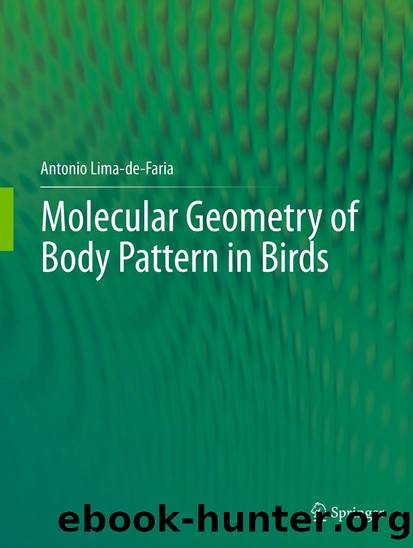Molecular Geometry of Body Pattern in Birds by Antonio Lima-de-Faria

Author:Antonio Lima-de-Faria
Language: eng
Format: epub
Publisher: Springer Berlin Heidelberg, Berlin, Heidelberg
8.2 Mathematicians and Physicists Know that there is not One, but Several Geometries – Euclidean and Non-Euclidean Geometries
Nothing is known of Euclid’s life and the dates of his birth and death: 325–250B.C. are uncertain. But his book “The Elements” has remained the reference work on geometry for over 2,000 years. It was written in 13 volumes (1–6 on plane geometry, 7–9 on the theory of numbers, 10 on irrationals, 11–13 on solid geometry). Other extant works attributed to him are two treatises on music: “Section of the Canon” and “Harmonica”. Music, like geometry, is also based on order and as such was not left outside his working domain (Hornblower and Spawforth 1999).
Geometry contains an element of beauty, due to its harmony and simplicity. In 1847 an edition was made of the first six volumes of the “Elements” by colouring in yellow, red, blue, black and white all the numerous figures. The purpose was to make this work more appealing and easier to grasp by students of mathematics (Byrne 1847) (Reprinted 2010).
The Euclidean geometry deals with circles, triangles and other geometric figures drawn on a flat two-dimensional surface. In this type of geometry one measures the exact dimensions of a circle or the value of the angles in a triangle. When the same triangles and circles are laid out on the surface of the Earth, they do not obey the ordinary flat Euclidean geometry. On the curved surface of the Earth, the square of the hypotenuse of a right-angled triangle is smaller than the sum of the squares of the two sides. Still more strange is that on the Earth’s surface, the sum of the interior angles of a triangle is more than 180°, and the circumference of a circle of radius r is less than 2 π r (Ohanian 2009). In a spherical structure another geometry applies which is called non-Euclidean geometry.
In 1915 Albert Einstein (1879–1955) developed his general theory of relativity. He had found that his relativity concept required that the space of the universe be considered a non-Euclidean space. It needed the type of geometry devised by the mathematician Georg Riemann (1826–1866) who had changed the concepts of distance and curvature into a multidimensional geometry. For Einstein space-time might have a different geometry at different locations and he created a curved space-time geometry that fitted his expanded view of relativity.
Download
This site does not store any files on its server. We only index and link to content provided by other sites. Please contact the content providers to delete copyright contents if any and email us, we'll remove relevant links or contents immediately.
Sapiens: A Brief History of Humankind by Yuval Noah Harari(13054)
The Tidewater Tales by John Barth(12030)
Do No Harm Stories of Life, Death and Brain Surgery by Henry Marsh(6337)
Mastermind: How to Think Like Sherlock Holmes by Maria Konnikova(6236)
The Thirst by Nesbo Jo(5786)
Why We Sleep: Unlocking the Power of Sleep and Dreams by Matthew Walker(5644)
Sapiens by Yuval Noah Harari(4538)
Life 3.0: Being Human in the Age of Artificial Intelligence by Tegmark Max(4509)
The Longevity Diet by Valter Longo(4446)
The Rules Do Not Apply by Ariel Levy(3906)
The Immortal Life of Henrietta Lacks by Rebecca Skloot(3826)
The Body: A Guide for Occupants by Bill Bryson(3802)
Why We Sleep by Matthew Walker(3773)
Animal Frequency by Melissa Alvarez(3755)
Yoga Anatomy by Kaminoff Leslie(3702)
Barron's AP Biology by Goldberg M.S. Deborah T(3632)
The Hacking of the American Mind by Robert H. Lustig(3580)
All Creatures Great and Small by James Herriot(3517)
Yoga Anatomy by Leslie Kaminoff & Amy Matthews(3396)
